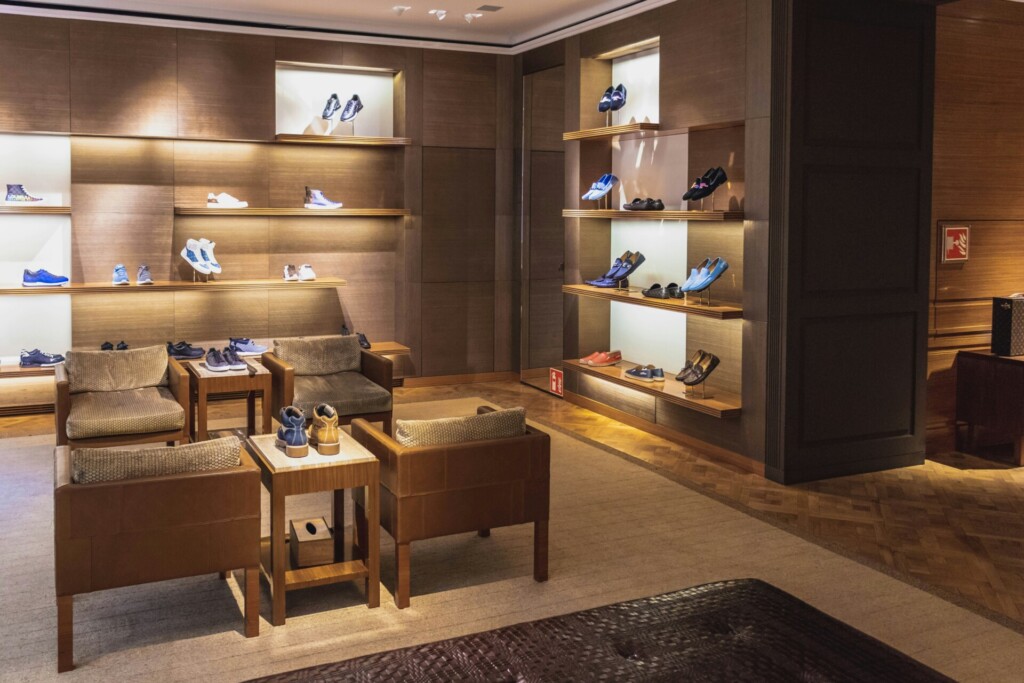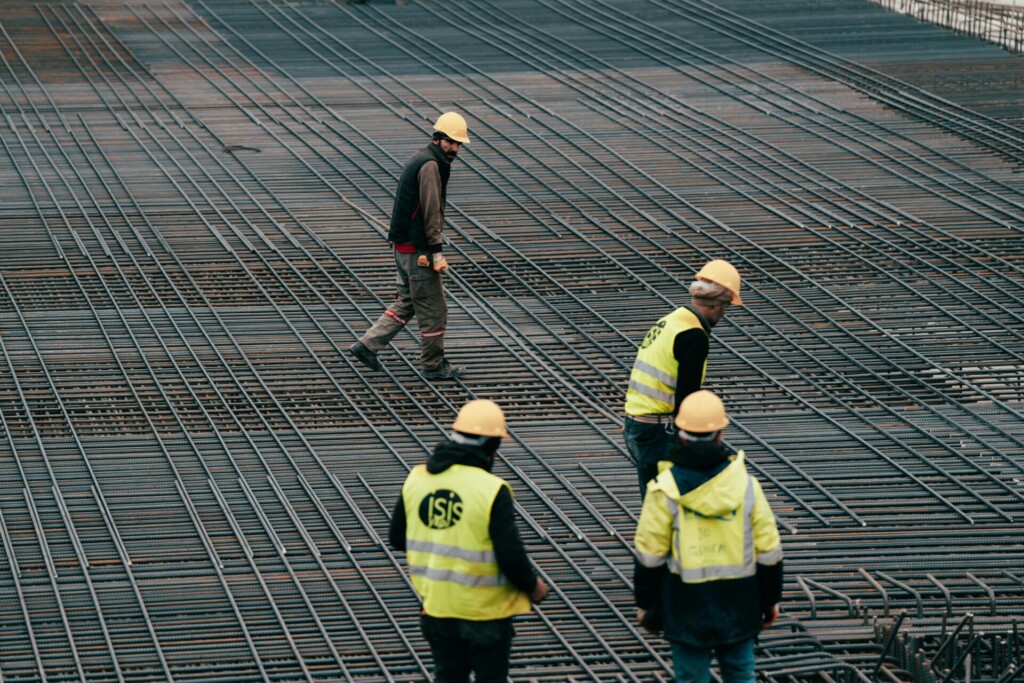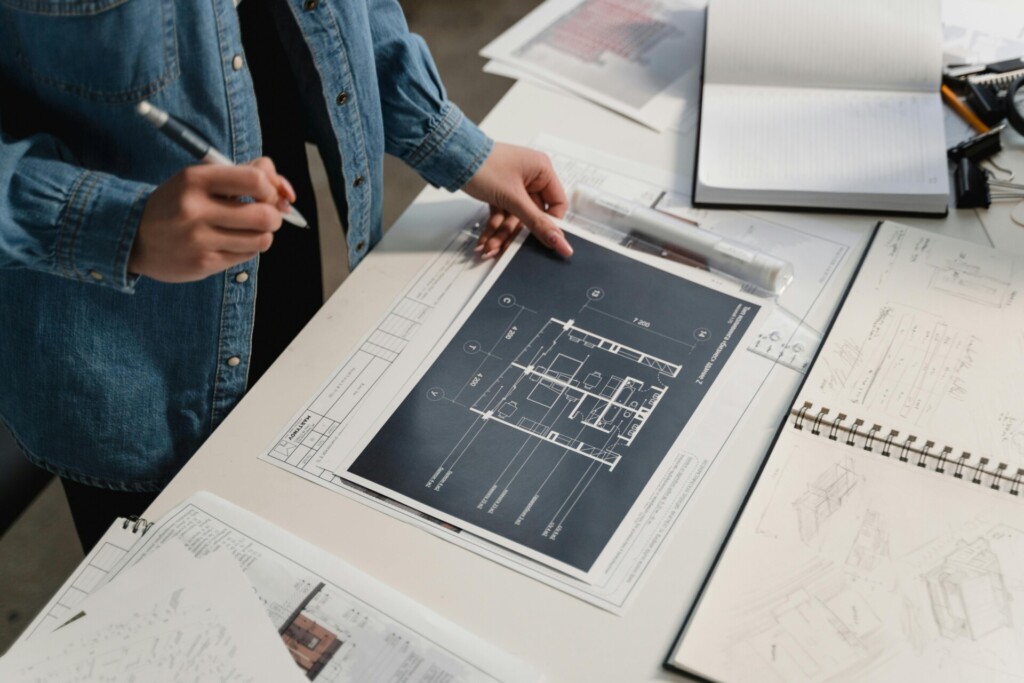When developers and property owners approach us about creating retail spaces, they seek more than just four walls and a roof. Retail construction is our specialized process of transforming commercial real estate into functional, attractive environments where businesses can effectively sell their products and services. From the initial site preparation to the final finishing touches, we aim to build spaces that enhance customer experiences and support business operations.
At EB3 Construction, we approach each retail project with a focus on what makes these spaces unique. Retail construction typically demands careful attention to visibility, traffic flow, and brand presentation. The recent challenges facing brick-and-mortar retailers have increased the need for thoughtfully designed spaces that can draw customers in and create memorable shopping experiences.
Effective retail construction aims to balance aesthetic appeal with practical functionality. We can coordinate complex systems like specialized lighting, security features, and climate control that work together. From small boutique storefronts to large shopping centers, each project may require us to adapt our construction methods to match the specific merchandising strategy of the business that will occupy the space. Our goal is to create retail environments that support a business”s ability to attract customers and facilitate sales.
What Are the Different Types of Retail Construction Projects?

At EB3 Construction, we can manage various retail construction projects, each with its own set of challenges and specifications. The retail sector typically demands construction solutions that accommodate practical business operations and create environments that aim to attract and retain customers. Understanding the distinct characteristics of each retail construction type helps us deliver spaces that can perform for our clients.
Shopping Centers and Malls
Mall construction represents one of the most complex retail endeavors in the industry. These enclosed shopping environments typically require careful planning of numerous interconnected elements: strategic entrance areas, efficient vertical transportation via elevators and escalators, safe balcony walkways, comfortable seating areas, and often decorative elements like water features and artwork.
When constructing lifestyle centers, the focus is usually on creating upscale, open-air environments without the traditional department store anchors found in conventional malls. These projects may feature premium dining options alongside high-end retail spaces, requiring sophisticated infrastructure and architectural detailing.
Power centers present a different challenge, as these large-scale developments typically house multiple big box retailers like Best Buy, Walmart, or Costco. Construction teams may coordinate extensive site work, manage large foundation pours, and implement complex mechanical systems to support these massive retail operations.
Community-Based Retail Construction
Neighborhood centers often serve as smaller community hubs anchored by essential services like grocery stores or pharmacies, complemented by local businesses. These construction projects typically focus on convenience and accessibility, with layouts that facilitate quick visits and easy navigation.
For community centers (often called strip malls), spaces are developed to accommodate diverse tenant needs. These typically feature two or more anchor tenants alongside specialty shops and convenience retailers. The construction often emphasizes storefront visibility, adequate parking, and flexible interior configurations to support various businesses.
Convenience centers represent a smaller retail construction category. These focused developments usually house essential service businesses like cell phone stores, dry cleaners, and similar quick-service operations. Despite their smaller footprint, these projects require careful attention to traffic flow, visibility, and efficient space utilization.
Specialized Retail Environments
Department store construction typically demands solutions for displaying diverse merchandise categories under one roof. This may involve implementing specialized lighting systems, appropriate HVAC zoning, and distinct department layouts while maintaining cohesive design elements throughout the space.
When building discount stores, the focus is often on creating large, efficient structures that maximize floor space and operational efficiency. These projects may involve coordinating with transportation authorities to ensure the surrounding infrastructure can support high customer volumes.
Specialty store construction requires understanding of specific product categories. Whether building a sporting goods outlet, electronics store, or fashion boutique, the approach can be tailored to showcase particular products effectively while reinforcing brand identity through architectural elements.
Food and Beverage Retail Construction
Grocery store and supermarket construction presents unique challenges with specialized electrical and plumbing requirements. Systems are typically implemented to support refrigeration equipment, freezers, and food preparation areas while creating functional layouts that enhance the shopping experience.
Restaurant construction spans various categories—from fast-food establishments to fine dining venues. This often involves navigating health and safety regulations while installing commercial-grade kitchen infrastructure, ventilation systems, and dining areas that align with the establishment”s brand positioning.
Factory outlet construction typically involves creating open-air retail spaces housing brand outlet stores. These projects often emphasize cost-effective construction methods while aiming to maintain an appealing shopping environment for customers seeking value from nationally recognized brands.
Emerging Retail Construction Categories
Mixed-use retail spaces represent one of the forward-thinking approaches to retail construction today. These developments combine retail, commercial, and residential spaces—typically with retail on ground floors and offices or housing above. Originally common in urban centers, this construction type has gained wider adoption due to its efficient land use and potential environmental benefits.
Showroom construction has evolved with the rise of omnichannel retail. These spaces often focus less on inventory storage and more on creating immersive brand experiences. Construction teams may implement advanced lighting, interactive displays, and flexible layouts that allow retailers to showcase products while complementing their online presence.
| Retail Construction Project Type | Size | Complexity | Common Features |
|---|---|---|---|
| Malls and Shopping Centers | Large | High | Entrance areas, vertical transportation, decorative elements |
| Lifestyle Centers | Medium to Large | High | Upscale focus, open-air environments |
| Power Centers | Large (200,000+ sq ft) | High | Big-box retailers, extensive site work |
| Neighborhood Centers | Small to Medium | Moderate | Anchored by essential services, local businesses |
| Community Centers | Medium | Moderate | Multiple anchor tenants, flexible layout |
| Convenience Centers | Small | Low | Quick-service operations, efficient space utilization |
| Department Stores | Large | High | Specialized lighting, HVAC zoning |
| Discount Stores | Large | Moderate | Efficient floor space, supportive infrastructure |
| Specialty Stores | Varies | Moderate to High | Tailored architectural elements, brand identity focus |
| Grocery Stores | Medium | High | Specialized electrical and plumbing, layout enhancement |
With each retail construction project, we aim to approach the unique requirements with thorough planning and precise execution. Understanding the specific operational needs, customer flow patterns, and brand requirements can help support the creation of retail environments that align with clients’ business objectives through carefully planned and executed construction.
What is Adaptive Reuse in Retail Construction?
Adaptive reuse is a strategic approach in construction that can transform existing structures into vibrant retail environments. This process involves converting underutilized spaces like vacant warehouses, former factories, or historic buildings into functional and appealing retail destinations.
Construction teams can specialize in preserving the character-defining elements of these structures while implementing modern upgrades to meet current building codes and retail requirements. This balance between preservation and modernization can create uniquely distinctive spaces that standard new construction may not replicate. Features such as exposed brick walls, original timber beams, and industrial elements can become signature characteristics that create memorable shopping experiences.
Economic and Environmental Benefits
Adaptive reuse projects often present potential cost advantages compared to ground-up construction. Typical cost savings range from 10% to 20%, depending on the project scope and existing structure condition. These savings can stem from decreased material needs, shorter construction timelines, and reduced demolition costs—all while maintaining the building”s structural integrity.
The environmental benefits can be equally compelling. Adaptive reuse projects can significantly decrease landfill waste by minimizing demolition. Repurposing existing buildings may divert substantial amounts of construction debris from landfills. Additionally, this approach can reduce the carbon footprint associated with producing and transporting new building materials, aligning with sustainability goals many developers and property owners prioritize.
From a regulatory perspective, adaptive reuse may allow for faster permitting processes in municipalities that incentivize historic preservation. Many cities offer streamlined approvals, zoning flexibility, and tax incentives for developers investing in revitalizing existing structures rather than demolishing them.
Community and Commercial Impact
The transformation of vacant or underperforming properties can create ripple effects throughout surrounding areas. Converting former industrial buildings in transitional neighborhoods into retail destinations may lead to increased property values beyond the immediate project site. Local municipalities can benefit from expanded tax bases as these once-dormant properties return to productive use.
These projects can become catalysts for broader neighborhood revitalization. A former warehouse converted into a mixed-use retail development in an urban core can create a thriving shopping destination and potentially spark further investment in nearby properties. The distinctive character of adaptively reused buildings helps create authentic retail environments that connect with consumers seeking unique experiences beyond conventional shopping centers.
For retail tenants, these spaces offer built-in differentiation in an increasingly competitive marketplace. The architectural heritage and stories embedded in repurposed buildings provide marketing opportunities that can resonate with experience-focused consumers. Many national retailers have embraced these distinctive environments as part of their brand identity, moving away from standardized storefronts to create more memorable customer experiences.
Technical Considerations in Implementation
Successfully executing adaptive reuse requires specialized construction expertise. Teams must address unique structural challenges, unexpected conditions, and complex building system integrations. The process typically begins with comprehensive structural assessments to verify the integrity of existing elements before developing detailed reinforcement strategies where needed.
Upgrading building systems presents particular challenges. Installing modern HVAC, electrical, and plumbing systems within existing structural constraints requires creative engineering solutions. Techniques like exposed ductwork and conduit that complement industrial aesthetics while meeting performance requirements are often employed. Similarly, enhancing insulation and energy efficiency in older buildings requires specialized approaches that maintain architectural character while improving operational performance.
Code compliance represents another critical consideration. Navigating complex building codes that sometimes contain special provisions for historic structures is essential. Expertise in these regulations allows for identifying compliance pathways that balance preservation with safety requirements. This might include implementing alternative fire protection measures, addressing accessibility standards, or upgrading structural elements to meet current seismic codes.
What Are Expert Tips for Successful Retail Construction?

At EB3 Construction, we understand that achieving success in retail construction depends on strategic planning and effective execution. When developing retail spaces for our clients, we aim to ensure projects stay on schedule and within budgetare cost-effective while creating environments that enhance business success. Here”s our guidance for addressing retail construction challenges.
Pre-Construction Planning
Retail projects typically begin with comprehensive planning before construction starts. This can involve conducting thorough site evaluations to identify potential issues with utility access, zoning requirements, or structural limitations. Investing time upfront may help prevent costly surprises later, especially when changes become more expensive.
During pre-construction, establishing clear communication protocols with all stakeholders is important. Recent supply chain fluctuations have made this even more critical—identifying long-lead items early and securing materials can help prevent schedule impacts. Coordinating closely with property management during this phase is also beneficial. They may have unique requirements, including specific working hours, noise restrictions, and protection of common areas. Understanding these parameters early helps develop realistic schedules that account for mall blackout dates or seasonal retail restrictions.
Design for Brand and Function
Retail construction often requires balancing brand expression and operational functionality. The layout should reflect the retailer”s identity while facilitating customer flow, maximizing sales opportunities, and supporting daily operations.
Working with architects and designers, construction teams can help translate brand concepts into buildable spaces. This may include evaluating material selections for durability in high-traffic environments and recommending alternatives when certain finishes might compromise performance. Construction teams can implement specialty lighting that enhances merchandise while creating the right ambiance for shoppers.
Flexible design elements have become increasingly important in retail construction. Building adaptable infrastructure that can accommodate future technology integration or layout changes without major reconstruction might include strategic placement of power sources, data connections, or modular fixture systems that can evolve with the retailer”s needs.
Budget and Schedule Management
Controlling costs while maintaining quality requires vigilant oversight throughout the retail construction process. Developing detailed budgets that account for all aspects of the project, from permitting and construction to fixtures and finishes, is important. Experience in retail construction allows for identifying potential cost overruns before they occur and suggesting value engineering solutions that preserve design intent.
Schedule management is equally critical in retail construction. Opening dates are often tied to lease commencements or seasonal shopping periods, making delays particularly costly. Implementing phased construction approaches when appropriate can allow certain areas to be completed while others remain under construction.
Regular budget and schedule reviews with all stakeholders can help keep projects aligned with expectations. These check-ins provide opportunities to address emerging issues before they impact the timeline or budget, ensuring transparency throughout the construction process.
Navigating Regulatory Compliance
Retail construction projects face unique regulatory challenges, from building codes to ADA requirements and health department regulations for food service areas. Maintaining up-to-date knowledge of these requirements and incorporating compliance into planning from day one is crucial.
Permitting specialists can understand the specific documentation needed for retail spaces and how to navigate local approval processes efficiently. This expertise is particularly valuable when working in jurisdictions with complex review procedures or when retrofitting older buildings to meet current codes.
Developing strong relationships with code officials and inspectors can help resolve compliance questions quickly. For complex issues, bringing in specialized consultants early to address concerns before they become obstacles can be an effective approach in securing timely approvals for retail clients.
Execution and Quality Control
During active construction, implementing rigorous quality control procedures helps ensure work meets specifications and brand standards. Superintendents can conduct regular inspections at critical milestones, addressing any issues immediately rather than waiting for punch lists.
Coordinating closely with retail tenants” vendors for fixture installation, merchandising systems, and technology integration helps ensure that all elements work together seamlessly and that the space is ready for merchandise upon completion. Construction teams can be trained to protect finished surfaces during these installations, preventing damage that could delay opening.
Construction in active retail environments requires special attention to safety and security. Implementing comprehensive site protection measures to prevent dust infiltration into adjacent spaces and maintain clear pathways for emergency egress is important. These protocols protect both workers and the public while minimizing disruption to neighboring businesses.
Post-Construction Support
Providing detailed documentation of all building systems, including as-built drawings and maintenance requirements, can help facility managers maintain the space properly and troubleshoot any issues that arise.
Conducting training sessions for store personnel on building systems operation, from lighting controls to HVAC systems, ensures that staff can manage day-to-day functions effectively and know when to call for professional maintenance.
Post-occupancy follow-ups can be conducted to address any warranty items promptly. This approach demonstrates a commitment to long-term client satisfaction and can lead to ongoing relationships for future locations or renovations.
| Project Type | Size | Complexity | Common Features |
|---|---|---|---|
| Shopping Centers and Malls | Large | High | Strategic entrances, vertical transportation, balcony walkways |
| Power Centers | Very Large | Moderate | Big box retailers, large foundation pours |
| Community-Based Retail | Medium | Low to Moderate | Anchor tenants, diverse tenant needs |
| Convenience Centers | Small | Low | Quick-service operations, traffic flow management |
| Mixed-Use Retail | Variable | Moderate to High | Combination of retail, commercial, and residential spaces |
| Showroom | Variable | High | Immersive brand experiences, flexible layouts |
Technology Integration in Retail Construction
Modern retail spaces increasingly rely on technology to enhance the customer experience and operational efficiency. Integrating these systems during construction rather than treating them as afterthoughts is beneficial. This can include infrastructure for digital displays, interactive kiosks, security systems, and inventory management technology.
By coordinating technology installation with construction activities, conflicts between systems can be prevented, ensuring that all components function properly at opening. Experience with retail-specific technology helps clients make informed decisions about which systems may best support their operational goals.
Advanced solutions like integrated audio-visual systems, automated lighting controls, and energy management systems can be implemented to enhance operational efficiency while enhancing the shopping environment. These technologies may contribute to both the customer experience and the retailer”s operational efficiency.
What Components Are Essential in New Retail Construction?

Strategic Storefront Design
In retail construction projects, the storefront is a crucial element as it represents the customer”s first physical interaction with the brand. Effective storefronts typically combine structural integrity with visual appeal through carefully selected materials and proportions. Aluminum framing systems can provide both durability and flexibility, allowing for expansive glass walls that maximize visibility while maintaining structural support.
Storefront glass systems require thoughtful consideration beyond basic transparency. Appropriate glazing options can be selected based on energy efficiency needs, security requirements, and aesthetic goals. Low-emissivity glass may help maintain interior temperature control while allowing natural light to showcase merchandise, which can contribute to an inviting atmosphere.
The entrance design is an important aspect of the construction process. Doorways can be sized and positioned to create a natural transition from exterior to interior, with hardware selections that reflect quality standards while meeting functional requirements for security and accessibility.
Comprehensive Lighting Solutions
Lighting fundamentally shapes the retail environment and can be approached as both technical infrastructure and a design element. Layered lighting systems that combine ambient, accent, and task lighting can create depth and highlight merchandise effectively. This strategic approach may allow retailers to guide customer attention and create distinct zones within the space.
Energy efficiency considerations often drive lighting decisions. LED fixtures can provide color rendering, which is important for product presentation. Proper placement of lighting tracks, recessed fixtures, and specialty lighting elements requires coordination with ceiling systems, HVAC components, and sprinkler layouts during the construction phase.
Natural lighting integration has become increasingly important in retail construction. Maximizing storefront glass exposure where appropriate and sometimes incorporating skylights or clerestory windows can bring daylight deeper into the space. This approach may support sustainability goals while creating a comfortable shopping environment for customers.
Functional Layout and Traffic Flow
The physical layout of a retail space can impact customer behavior and operational efficiency. Detailed floor plans typically balance display areas, service points, storage needs, and circulation paths. Construction elements like wall placements, flooring transitions, and ceiling height variations can help define functional zones within the unified space.
Circulation paths are an important consideration during the build phase. Primary aisles can be constructed with appropriate widths for accessibility compliance while ensuring secondary pathways provide efficient movement throughout the store. The physical flow created through construction should align with the retailer”s merchandising strategy and customer journey.
Flexibility is often a priority in retail construction approaches. Modular wall systems, movable fixtures, and adaptable infrastructure can allow the space to evolve with changing inventory, seasonal promotions, or future concept updates. This built-in flexibility may contribute to the longevity and adaptability of the retail environment.
| Mall Construction | Complex, requires planning of entrances, elevators, walkways, and decorative elements |
| Lifestyle Centers | Open-air, upscale environments without traditional anchors |
| Power Centers | Large-scale, big box retailers requiring extensive site work and mechanical systems |
| Neighborhood Centers | Community hubs with convenient layouts anchored by essential services |
| Community and Strip Malls | Spaces with diverse tenant needs focused on visibility and flexible configurations |
| Convenience Centers | Small retail spaces with focus on flow, visibility, and space utilization |
| Department Stores | Need specialized lighting, HVAC zoning, and cohesive design |
| Discount Stores | Maximize floor space and efficiency; coordinate transport infrastructure |
| Specialty Stores | Tailored approach with architectural elements that reinforce brand identity |
Accessibility and Compliance Standards
Accessibility requirements can be integrated into every aspect of the retail construction process, from entrance design to interior pathways. Compliance with ADA standards shapes approaches to doorways, aisle widths, counter heights, and restroom facilities. Universal design principles can make spaces welcoming to all customers.
Clear, level pathways with appropriate widths are fundamental to construction standards. Smooth transitions between flooring materials and adequate clearances throughout the space are important considerations. Threshold details at entrances typically receive attention to address potential tripping hazards while maintaining weather sealing.
Restroom construction in retail environments requires coordination of plumbing systems, privacy considerations, and accessibility requirements. Adequate fixture clearances, appropriate grab bar installations, and proper door swing clearances are important details to address during the construction phase to avoid potential corrections later.
Integrated Technology Systems
Modern retail construction often requires infrastructure for technology integration. Comprehensive wiring systems can support point-of-sale stations, security systems, digital displays, and internet connectivity. This infrastructure should be sufficient for current needs and adaptable for future technology adoption.
Security elements can be integrated throughout the construction process. Appropriate backing for camera mounting locations, coordination of access control systems at entry points, and proper positioning of alarm system components are typical considerations. These elements should be functionally effective while remaining visually unobtrusive.
Digital display integration has become increasingly important in retail environments. Coordinating power and data requirements for these elements during the construction phase can ensure clean installation and proper viewing angles. Whether for wayfinding, promotions, or interactive experiences, these technology components should function seamlessly within the physical space.
Conclusion: Building Successful Retail Spaces
Crafting effective retail environments requires more than just construction expertise—it demands a holistic understanding of how physical spaces can drive business success. We aim to approach each retail project with this perspective, balancing aesthetic considerations with practical functionality to create spaces that can work for both property owners and their customers. When managing retail construction, our goal is not just to build walls and install fixtures, but to create a foundation upon which retail businesses may operate for years to come.
Our experience suggests that successful retail construction typically hinges on several critical factors. Communication often remains paramount throughout the project lifecycle, from initial planning through final inspections. We can coordinate closely with architects, designers, subcontractors, and code officials to navigate the complexities of modern retail requirements. The post-pandemic retail landscape has introduced new challenges, with many spaces now potentially requiring more flexible layouts and improved ventilation systems to meet changing consumer expectations. Through careful planning and proactive problem-solving, we aim to address these challenges and explore opportunities for innovation.
Ready to bring your retail vision to life with a construction partner who understands the unique demands of commercial spaces? Contact EB3 Construction to discuss your project needs.




